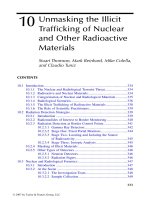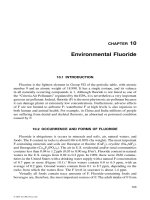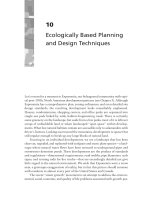Radiation and Health - Chapter 10 ppt
Bạn đang xem bản rút gọn của tài liệu. Xem và tải ngay bản đầy đủ của tài liệu tại đây (211.17 KB, 12 trang )
Chapter 10
Radiation and Health. Large Doses
It was noted earlier that radiation can produce biological effects. Around the
turn of the century a number of experiments were carried out, which, would be
characterized today as dangerous and foolhardy. It was found that ionizing
radiation was capable of developing skin burns and could cause hair to fall out.
In 1899, Stenbeck and Sjögren from Sweden used radiation to remove a tumor
from the nose of a patient. This showed that radiation in large doses could be
used to kill cancer cells.
In the early years, when radium was used for treatment, the sources were made
in the form of capsules or small tubes. The procedure for radium treatment was
either to use a large source of radium (teletherapy) or to use a number of small
sources for brachytherapy. In the latter case, paraffin wax was often used and
formed to suit the part of the body to be irradiated. Small needles of radium
were then sealed into the wax. This procedure gave a good dose distribution
when skin ailments and tumors were treated. The general view at that time was
that the radiation from radioactive sources was healthy and was a good treatment
for most sufferings. Figure 10.1 (next page) shows an advertisement from 1913.
Some people made good money by producing radioactive drinking water. A
number of small towns in middle Europe such as Badgastein, Baden-Baden,
Marienbad, and Karlovy Vary had radioactivity in their water and were con-
sidered to be healthy places.
With the use of a jar and some radium salt (Figure 10.1), the water was saturated
with radon when radium disintegrated. The belief was that by drinking this
water you received “curative” radioactivity. In those days, like today, some
© 2003 Taylor & Francis
116
Radiation and Health
Figure 10.1. An advertisement from 1913 for radioactive drinking water. A
jar with water, a cylinder and some radium salt was used. When Ra-226
disintegrates, radon is formed and is released into the water. When the tap was
opened, radon was found in the water. The radiation doses were small and the
whole system was rather harmless. (Reproduced with permission from R.F. Mould (1980).)
© 2003 Taylor & Francis
117
Large Doses
people voluntarily tried out methods that had not been tested or proved effective.
In the early years, people were careless in the use of radiation and the handling
of radioactive sources. The reason for this negligence was a lack of knowledge
about radiation and its biological effects.
Today, there is great deal of information about the effects of ionizing radiation,
a great contrast to the lack of knowledge about the many chemicals in use.
However, researchers in the radiation field have not been able to transmit this
information to the public. The result is that the public has only an incomplete
knowledge about radiation and radiation health effects. In spite of the fact that
other human activities are far more hazardous than radiation, many people are
unnecessarily afraid.
Because large doses of radiation are known to kill cells, there is the possibilty
of using radiation to treat cancer when localized to a small area of the body.
Similar large whole-body doses can lead to death, which occurs in the course of
days or weeks.
When considering medium and small doses, the biological effect is considerably
more difficult to predict. The reason for this is the time lag between the exposure
and the observable biological effect. For solid cancers it may be several decades.
Marie Curie, and a number of the other radiation pioneers died from cancer;
thus, there are reasons to believe that their work with radiation was involved.
On the other hand, recent experiments have claimed that small doses may even
have a positive health effect (see Chapters 11 and 12).
In all discussions on the biological effects of radiation, the radiation dose is a
key issue. Without knowledge about the size of the dose it is meaningless to
discuss the effects. The relationship between the dose and effect is also a hot
issue in the community of research scientists. Knowledge about the dose–effect
curve is a requirement when discussing mechanisms and health risks of radiation.
Dose–Effect Curves
The effect of radiation depends upon the dose. The larger the dose, the larger
the effect. This relationship is called the dose–effect curve and may be demon-
strated with a simple example.
When using an ordinary camera, you know that it is important that the film be
exposed to the right amount of light. When exposed to a lot of light, the film
becomes black, and when exposed to very little light,the film is hardly darkened
.
© 2003 Taylor & Francis
118
Radiation and Health
The blackening of the film depends on the amount of light (i.e. the dose).This is
illustrated in Figure 10.2. The S-shaped curve obtained is called the dose–effect
curve.
Figure 10.2. Dose–effect curve for the darkening of film. The horizontal axis
represents the amount of light (dose) and the vertical axis gives the darkening
(effect).
In work with radiation and biological effects, the results are often given by such
dose–effect curves. In radiobiology a lot of interest is concentrated on the form
of dose–effect curves and, in particular, the form of the curves at small doses.
Small doses will be discussed in the next chapter; here the discussion will deal
with the effect of large doses.
What is a Large Dose?
In a discussion about the biological or health effects of radiation, the equivalent
dose unit, the sievert, is often used. Again, the equivalent dose (Sv) is equal to
the physical dose (Gy) multiplied by a radiation weighting factor (w
R
). In the
case of x- and γ-rays the weighting factor is 1. The dose in gray and the equivalent
dose in sievert have the same value. However, in the case of radon and its
daughter products which emit α-particles, a radiation weighting factor of 20 is
used. Neutrons and other high energy particles have weighting factors larger
than 1.
Dose
(amount of light)
Effect
(blackening of film)
The amount of light
which yields the best
© 2003 Taylor & Francis
119
Large Doses
The large dose region can be characterized in the following way:
Annual doses of 2 mGy to 5 mGy (such as those attained from natural background
radiation) are considered to be very small.
The Use of Large Doses
Large radiation doses are used for:
• Sterilization of medical equipment
Co-60 and Cs-137 γ-radiation are used to sterilize medical equipment. The
doses delivered are on the order of 20 to 40 kGy. The purpose of the radiation is
to kill bacteria, viruses, and fungi that contaminate equipment.
• Radiation of food products
The purpose is almost the same as for sterilizing equipment. The doses are,
however, smaller, on the order of 5 to 10 kGy. Larger doses may change the
taste of certain foods.
• Radiation therapy
In the radiation treatment of cancer, the purpose is to kill the cancer cells while
allowing nearby healthy cells to survive. Much effort is carried out to achieve
treatment protocols that will give the most effective treatments. The total dose
given to a tumor is 10 to 80 Gy. A treatment protocol may include daily doses of
2 Gy, given 5 days per week. The type of radiation is usually in the form of high
energy x-rays from linear accelerators (energies up to 30 MeV) which yield
suitable depth dose curves (see Figure 6.3). It is also possible to use electron
irradiation but the dosimetry becomes more complicated. The treatment is more
effective when the radiation dose is split up into a number of smaller doses
rather than giving the same total dose all at once.
A dose of more than 1 to 2 Gy is considered to be
large and a dose smaller than 0.1 to 0.2 Gy (100
to 200 mGy) is considered to be small.
© 2003 Taylor & Francis
120
Radiation and Health
The “fractioned dose treatment protocol” has the advantage of partly solving the
problems with hypoxic cells in a tumor (see Chapter 12). Experience has shown
that fractionated dose treatment yields the best results for tumor destruction while
minimizing damage to healthy tissue.
• Bone marrow transplantation
In combination with bone marrow transplantation which is used for the treat-
ment of certain illnesses, whole-body radiation is sometimes used with
chemotherapy to deplete the original bone marrow. The dose used is about 12
Gy (6 days with a daily dose of 2 Gy). This dose is sufficient to completely
destroy the bone marrow and would kill the patient if it were not for the immediate
transplant of new compatible bone marrow. A number of people have been treated
in this way.
LD
50
Dose
By definition, an LD
50
dose (abbreviation for “Lethal Dose to 50 percent”) is
the dose that could kill 50 percent of the individuals exposed within 30 days. To
arrive at a determination of the LD
50
dose, experiments like the following must
be carried out.
In typical experiments, rats, about 15 animals in each group, were given different
whole-body doses. The number of animals dying in the course of 30 days was ob-
served for each group. The result is given in Figure 10.3.
The dose is given along the horizontal axis and the number of animals dying ( in
percent for each group) is given along the vertical axis. The results show that no
animals survived a dose of 10 Gy, whereas all rats survived a dose of 5 Gy. It can be
seen that the LD
50
dose is approximately 7.5 Gy.
© 2003 Taylor & Francis
121
Large Doses
Figure 10.3. Dose–effect curve for radiation-induced death in rats.
When humans and animals are irradiated, the blood-forming organs (in the bone
marrow) will be the first to react. For doses of the order 1 to 2 Gy the number of
white and red blood cells will decrease as shown in Figure 10.4. As a result of this,
the immune system will fail and, after one to two weeks, life threatening infections
may occur. If the radiation doses are smaller than 4 to 5 Gy, there is a good
chance the bone marrow will recover and resume the production of blood cells.
This takes place after 3 to 4 weeks and, consequently, 30 days is a reasonably
chosen limit for the name acute radiation death. The LD
50
doses for a number
of animals have been determined and some values are given in Table 10.1. Sin-
gle cell organisms (for example bacteria, paramecium, etc.) may survive doses
of the order 2,000 to 3,000 Gy. (This is taken into consideration in radiation
treatment of food).
In the case of humans there is not enough information to determine a precise
LD
50
dose. The only information available has come from radiation accidents
and the lethality depends not only on the dose and dose rate but also the post-
exposure treatment given to the victims.
Radiation dose
(given in Gy)
Effect
(death of rats in percent)
Adapted from A.P. Casarett (1968) with permission from A.P. Casarett
© 2003 Taylor & Francis
122
Radiation and Health
Table 10.1: LD
50
doses
Figure 10.4. Whole-body irradiation results in changes in the number of blood
cells. This figure shows the results of a moderate dose to rats.
laminafoepyTyGniesoD
goD5.3
yeknoM6
taR5.7
gorF7
tibbaR8
esiotroT51
hsifdloG32
namuH5-3
Time in days after radiation
Percent of control
Erythrocytes
Platelets
Granulocytes
Lymphocytes
Adapted from A.P. Casarett (1968) with permission from A.P. Casarett
© 2003 Taylor & Francis
123
Large Doses
Acute Radiation Sickness
In 1906, Bergonie and Tribondeau found that there were different radiation
sensitivities for different types of mammalian cells. Cells which grow rapidly
(high mitotic rate), as well as undifferentiated cells, are the most sensitive.
This implies that bone marrow, testes, ovaries and epithelial tissue are more
sensitive than liver, kidney, muscles, brain and bone. Knowledge about this is
of great importance for those exposed to ionizing radiation. The bone marrow
and the epithelial cells of the intestine and the stomach as well as the gonads, the
lymphocytes and skin develop the greatest damage. Damage to the bone marrow
is the cause of death for whole-body doses in the region 3 to 10 Gy, whereas
damage to the epithelial cells of the stomach and intestine is the cause of death
for doses in the range from 10 to 100 Gy. For large doses, above100 Gy, damage
to the central nervous system causes death.
Figure 10.5. Survival curves for bone marrow cells of the mouse after
irradiation with Co-60 γ-radiation.
Adapted from A.P. Casarett (1968) with permission from A.P. Casarett
Radiation dose
(in Gy)
Survival
(in percent)
© 2003 Taylor & Francis
124
Radiation and Health
• Hematopoietic syndrome
As mentioned above, the failure of the bone marrow is the cause of death for whole-
body doses in the range of 3 to 10 Gy. The radiation may either kill these cells
or arrest their development. A dose of 5 Gy will kill about 99% of the
hematopoietic stem cells in mice (see Figure 10.5). These stem cells are neces-
sary for the production of circulating blood cells (erythrocytes, granulocytes and
platelets). A reduction of these cells will result in anemia, bleeding and infec-
tions.
The first sign of such radiation sickness is nausea, vomiting and diarrhea. This
situation may disappear after a couple of days. Then, the consequences of lost
blood cells become evident. Again, significant diarrhea may take place, often
bloody, and a fluid imbalance may occur. This, together with bleeding, occurs in
all organs. In addition, if infections occur, death may take place in the course of
a few weeks.
• Gastrointestinal syndrome
For whole body doses of 10 to 100 Gy, the survival time is rarely more than one
week. Damage to the epithelium of the intestine results in significant infections
from the bacteria in the intestine itself. The production of blood cells is almost
completely stopped, and those remaining in the blood disappear in the course of
a few days. After 2 to 3 days almost all granulocytes will have disappeared
from the circulation.
The symptoms are pain in the stomach and intestine, nausea, vomiting and
increasing diarrhea. A considerable loss of liquids and electrolytes will change
the blood serum composition. There is an increased chance of infections.
• Central nervous system syndrome
For radiation doses above 100 Gy, the majority may die within 48 hours as the
result of the central nervous system syndrome. The symptoms are irritability and
hyperactive responses (almost like epileptic attacks) which are followed rapidly
by fatigue, vomiting and diarrhea. The ability to coordinate motion is lost and
shivering occurs followed by coma. Then respiratory problems occur which
eventually lead to death.
The symptoms described are due to damage to the brain, nerve cells and blood
vessels. Immediately, permeability changes take place in the blood vessels re-
sulting in changes in the electrolyte balance. The loss of liquid from the blood
© 2003 Taylor & Francis
125
Large Doses
vessels leads to increased pressure in the brain. It is possible that the respiration
center in the brain is particularly damaged. Autopsies have shown that some animals
die without visible damage to the brain.
A radiation accident
In September 1982 a fatal radiation accident occured in a laboratory for radiation-
induced sterilization of medical equipment in Norway. An employee was exposed to
a large γ-dose. He was the only person at work when the accident happened. A
coincidence of technical failures with a safety lock and an alarm light, together with
neglect of the safety routines, resulted in the fact that he entered the room with the
source in the exposure position. The drawing below shows the radiation facility. The
source is Co-60 with an activity of 2430 TBq.
The employee was found outside the
laboratory in the early morning with clear
signs of illness. Since he had heart pro-
blems (angina pectoris), it was first assumed
that he had a heart attack. However, it
became clear that he had been exposed to
radiation. The man had acute radiation
syndrome with damage to the blood forming
tissue.
His blood counts went down almost like
that shown in Figure 10.4. He was treated
with antibiotics and several blood
transfusions but died 13 days after the
accident.
It is important to the know the dose he
received. Using electron spin resonance
(ESR)-dosimetry the dose was determined
(see next page). The man had been
exposed to a whole-body dose of
approximately 22.5 Gy. The bone marrow
dose was 21 Gy, whereas the dose to the
brain was calculated to be 14 Gy.
Control room
Concrete
Control panel
Irradiation room
Corridor
Steel door
Dosemeters
Co-60 source
2430 TBq
1.25 m
© 2003 Taylor & Francis
126
Radiation and Health
Dose determination and radiation accidents
In order to determine the dose after an
accident, one must use changes or damages
produced by radiation that are relatively per-
manent. One type of damage that fills this
requirement is the formation of free radicals
in solid matter (clothes, nails, teeth, etc.).
In the accident described above, the victim
used nitroglycerol tablets because of heart
problems. He always carried a small box
containing these tablets. The tablets were
irradiated during the accident and rather
stable radicals were formed. The number of
radicals formed yields information about the
radiation dose. Radical concentrations were
measured using ESR spectroscopy (see
Chapter 12 ).
The accidental dose was determined by using
the same type of tablets. Exposing them to
known doses from 1 to 80 Gy, a calibration curve
was obtained. The curve was then used to
show that the tablets irradiated during the
accident received a dose of about 40 Gy.
Then, measurements were made with a phantom
which was placed in the exposure room at the
same position as the victim. A number of TLD-
dosimeters were used and it was found that
a dose of 40 Gy to the position of the box
with the nitroglycerol tablets (in his pocket)
yielded an average whole body dose of 22.5
Gy.
Conclusion: ESR spectroscopy can be used
for dose determinations, even after an
accidental exposure.
It is a great challenge to determine the doses in radiation accidents. The reason
is obvious because accidents take place without warning and mainly without
adequate equipment for dose determination.
Radiation workers usually have a dosimeter and, in the accident described above,
the employees used film dosimeters. The film can be used for doses up to about
1 Gy but is not applicable for fatal or near fatal doses. Below, we demonstrate
how the radiation dose was determined for this accident.
Radiation dose in Gy
Effect (number of radicals)
Calibration curve
Irradiated during accident
Radical formation in
nitroglycerol tablets
E. Sagstuen, H. Theisen and T. Henriksen (1983)
© 2003 Taylor & Francis









